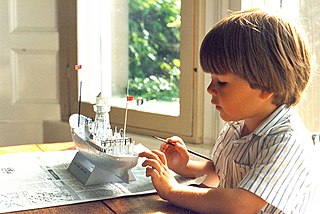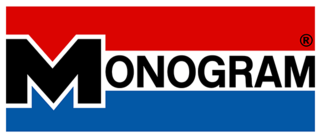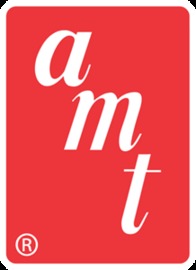
Matchbox is a toy brand which was introduced by Lesney Products in 1953, and is now owned by Mattel, Inc, which purchased the brand in 1997. The brand was given its name because the original die-cast "Matchbox" toys were sold in boxes similar to those in which matches were sold. The brand grew to encompass a broad range of toys, including larger scale die-cast models, plastic model kits, slot car racing, and action figures.

A plastic model kit,, is a consumer-grade plastic scale model manufactured as a kit, primarily assembled by hobbyists, and intended primarily for display. A plastic model kit depicts various subjects, ranging from real life military and civilian vehicles to characters and machinery from original kit lines and pop fiction, especially from eastern pop culture. A kit varies in difficulty, ranging from a "snap-together" model that assembles straight from the box, to a kit that requires special tools, paints, and plastic cements.

Revell GmbH is an American-origin manufacturer of plastic scale models, currently based in Bünde, Germany. The original Revell company merged with Monogram in 1986, becoming "Revell-Monogram". The business operated until 2007, when American Revell was purchased by Hobbico, while the German subsidiary "Revell Plastics GmbH" had separated from the American firm in 2006 until Hobbico purchased it in 2012, bringing the two back together again under the same company umbrella. After the Hobbico demise in 2018, Quantum Capital Partners (QCP) acquired Revell.

A die-cast toy is a toy or a collectible model produced by using the die-casting method of putting molten lead, zinc alloy or plastic in a mold to produce a particular shape. Such toys are made of metal, with plastic, rubber, glass, or other machined metal parts. Wholly plastic toys are made by a similar process of injection molding, but the two methods are distinct because of the properties of the materials.

Maisto is a brand of scale model vehicles introduced in 1990 and owned by May Cheong Group, a Chinese company founded in 1967 in Hong Kong by brothers P.Y. Ngan and Y.C Ngan. Head-quartered in Hong Kong, the brand has its offices in the United States, France and China. MCG also owns other model car brands such as former Italian brand Bburago and Polistil.

Schuco is a German brand and former manufacturing company founded in 1912 by Heinrich Müller and the businessman Heinrich Schreyer in Nuremberg, popularly known as Germany's toy capital. The company's specialty was making toy reproductions of cars and trucks in tin, plastic and die-cast. The company went bankrupt in 1976 but was reorganized in 1993 and then totally independent again by 1996 before its acquisition by the Simba Dickie Group in 1999.

Majorette is a French toy manufacturer which mostly produces small Die-cast scale model cars, commercial vehicles, aircraft, and other vehicles, particularly in 1:64 scale. This is a normal 2.5–3 in (64–76 mm) size, thus Majorette has sometimes been called "the Matchbox of France". Traditionally, production was centered in the urban area of Lyon, but diecast models are now made in China, the Philippines, Taiwan, Thailand and Vietnam.

Monogram is an American brand and former manufacturing company of scale plastic models of cars, aircraft, spacecraft, ships, and military vehicles since the early 1950s. The company was formed by two former employees of Comet Kits, Jack Besser and Bob Reder.

Playart was a toy company owned by Hong Kong industrialist Duncan Tong (唐鼎康) that specialized in die-cas toy cars, similar in size and style to Hot Wheels, Matchbox or Tomica. Cars were well done, but were often diecast seconds from other companies like Yatming or Tomica. Cars were made from 1965 to 1983 at the factory in San Po Kong, Kowloon, Hong Kong. Plastic cars and trucks of 1:43, and 1:24 scale were also made, while trains and other theme toys also appeared.
1:18 scale diecast replicas are 1/18th the size of the real vehicle. Most popular in this category are 1:18 scale automobile replicas – usually made out of Zamak zinc diecasting alloy with plastic parts. "1:18 scale" is the colloquial reference to this class of toy or replica.

Jo-Han was a manufacturer of plastic scale promotional model cars and kits originally based in Detroit. The company was founded in 1947 by tool and die maker John Hanley a year before West Gallogly's competing company AMT was formed and about the same time as PMC. After changing ownership a few times, Jo-Han models were sporadically manufactured by Okey Spaulding in Covington, Kentucky, but apparently none have been offered for several years.

Aluminum Model Toys (AMT) is an American brand of scale model vehicles. The former manufacturing company was founded in Troy, Michigan, in 1948 by West Gallogly Sr. AMT became known for producing 1:25 scale plastic automobile dealer promotional model cars and friction motor models, and pioneered the annual 3-in-1 model kit buildable in stock, custom, or hot-rod versions. The company made a two-way deal in 1966 with Desilu Productions to produce a line of Star Trek models and to produce a 3/4 scale exterior and interior filming set of the Galileo shuttlecraft. It was also known for producing model trucks and movie and TV vehicles.

Solido is a French brand and former manufacturing company of die-cast scale models of cars, military vehicles and commercial vehicles. The models are usually made of a zamac alloy in varying scales.

The Aurora Plastics Corporation was an American toy and hobby manufacturing company. It is known primarily for its production of plastic scale models of cars, airplanes, and TV and movie figures in the 1960s. Its principal competition in modeling were various other plastic modeling firms like Revell and Monogram.
The Hubley Manufacturing Company was an American producer of a wide range of cast-iron toys, doorstops, and bookends. Toys, particularly motor vehicles and cap guns, were also produced in zinc alloy and plastic. The company is probably most well known for its detailed scale metal kits of Classic cars in about 1:20 scale. Starting in 1960, Hubley participated for a couple of years with Detroit automakers as a plastic promotional model maker. Many Hubley toys are now sought-after collectibles.

Model Products Corporation, usually known by its acronym, MPC, is an American brand and former manufacturing company of plastic scale model kits and pre-assembled promotional models of cars that were popular in the 1960s and 1970s. MPC's main competition was model kits made by AMT, Jo-Han, Revell, and Monogram.

Gama is a German maker of toys, usually cars and trucks, dating from before World War I. The company is headquartered in Fürth, Bavaria, near Nürnberg, a traditional German toymaking center. Other German companies that competed with Gama Toys were Schuco Modell and Conrad Models.

RIO Models was an Italian manufacturer of diecast and plastic 1:43 scale model cars, based in Cernobbio, Italy.
Product Miniature Company, or known by the acronym PMC, was a company that manufactured pre-assembled plastic promotional models cars, banks and toys in Milwaukee, Wisconsin. It was started by brothers William Edward "Ed" and Paul Ford in 1946. Car model production, the company mainstay, ended about 1965. In 1958 or 1959 the company moved to Pewaukee, west of Milwaukee, and remains there to this day, now producing other plastic promotional products, but not vehicles. Sigmunt "Zigmund" Alexander Suchorski worked as a molding machine operator for Product Miniature in Milwaukee




























